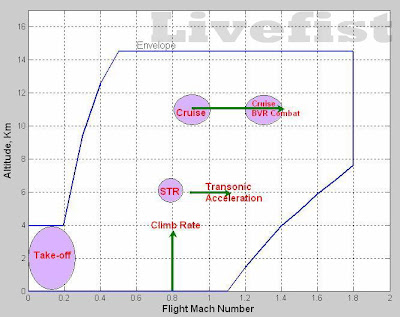BAJRANGBAL
New Member

Official Wishlist of Evolutionary Technologies for Indian 5th Gen AMCA
One of the most dramatic aspects of India's concept fifth generation Advanced Medium Combat Aircraft (AMCA) will be its cockpit and man-machine interface. For starters, unlike the cluttered, resoundingly less-than-fourth-generation cockpit of the Light Combat Aircraft (LCA Tejas), the AMCA cockpit could have a panoramic active-matrix display. Next, switches, bezels and keypads could be replaced with touch screen interfaces and voice commands. Finally, what the team wants is for the AMCA pilot to have a helmet-mounted display system that allows the jettisoning of a HUD from the AMCA cockpit altogether.
AMCA documents that provide the first detailed view
The AMCA team has already asked private industry in the country to explore the feasibility of creating primary panoramic displays and other avionics displays that would befit a fifth generation cockpit environment. But the cockpit is just one of an ambitious official technology wishlist for the AMCA.
The envisaged changes begin at the very basic -- system architecture -- and look towards a triplex fly-by-light electro-optic architecture with fiber optic links for signal and data communications, unlike the electric links on the Tejas platform. And unlike centralized architecture on the Tejas, the AMCA proposes to sport a distributed architecture with smart sub-systems. Similarly, unlike the LCA's centralised digital flight control computer (DFCC), the AMCA could have a distributed system with smart remote units for data communication with sensors and actuators, a system that will necessitate much faster on-board processors.
Next come sensors. The mechanical gyros and accelerometers on the Tejas will need to evolve on the AMCA into fiber optic gyros, ring laser gyros and MEMS gyros. The pressure probes and vanes that make up the air-data sensors will evolve into an optical and flush air data system, and position sensors will be linear/rotary optical encoders. Significantly, actuators -- currently electro-hydraulic/direct drive -- could be electro-hydrostatic to accrue substantive weight savings on the AMCA. Sensor fusion for an overarching situation picture goes without saying.
The AMCA could feature highly evolved integrated control laws for flight, propulsion, braking, nose wheel steer and fuel management and adaptive neural networks for fault detection, identification and control law reconfiguration.
Stealth
The official CAD images above, from the Advanced Projects & Technologies (AP&T) directorate of India's Aeronautical Development Agency (ADA) provide further perspective on the low-observable design elements that are known to be going into India's Advanced Medium Combat Aircraft (AMCA), known for a while now to be a stealth aircraft concept. Serpentine air intakes (with minimum flow distortion and robust pressure recovery) and internal weapons bays, depicted in the images above, are some of the most critical nose-on low observability design elements going into the programme.
As part of the multidisciplinary design optimization (MDO) currently on for the AMCA -- a wind tunnel model of which was first publicly displayed at AeroIndia 2009 -- that design-based stealth features will include further optimized airframe shaping, edge matching, body conforming antennae and a low IR signature through nozzle design, engine bay cooling and work on reduced exhaust temperature. RAMs, RAPs, special coatings for polycarbonate canopy and precision manufacturing will all be part of the effort to make the AMCA India's first stealth airplane.
With aerodynamic design optimisation near complete, the AMCA's broad specifications are final. The aicraft will have a weight of 16-18 tons [16-18 tons with 2-tons of internal weapons and 4-tons of internal fuel with a combat ceiling of 15-km, max speed of 1.8-Mach at 11-km. The AMCA will be powered by 2 x 90KN engines with vectored nozzles. For the record, the official ADA document that will finally be processed this year by the government towards formal project launch describes the AMCA as a "multirole combat aircraft for air superiority, point air defence, deep penetration/strike, special missions".
Unlike the Tejas, which features an avionics systems architecture based on functionality-based individual computer systems connected on MIL-STD-1553B buses and RS 422 links, the AMCA's avionics systems architecture will feature a central computational system connected internally and externally on an optic fiber channel by means of multiport connectivity switching modules. In such a system, functionality will be mapped on resourcred optimally and reallocated when faults occur. At least, that's the idea. Data communications on the AMCA's processing modules will be through a high-speed fiber channel bus, IEEE-1394B-STD. The connectivities will be switched by means of a multiport switching matrix, with data speeds of 400MB/second.
The AMCA could have integrated radio naviation systems, where all functions earlier done by analogue circuits will be shifted onto the shoulders of digital processors. Communication system will be based on software radio ranging from UHF to K band, with data links for digital data/voice data and video.
Algorithms will evolve substantially too. While the Tejas features almost no decision aid, the AMCA pilot could have at his command the ability to plan attack strategies, avoid strategies, retreat strategies and evasive strategies for himself and his buddies. Limited fault recording and limited coverage in the maintenance and diagnostics algorithms on the LCA will evolve into far more advanced ones allowing extensive coverage.
This is an official technology wishlist for the AMCA.
Here is a nice little slide illustrating the AMCA's envisaged operational envelope (subject of course to change).

First photos of the AMCA wind-tunnel model from last year
Last edited:
